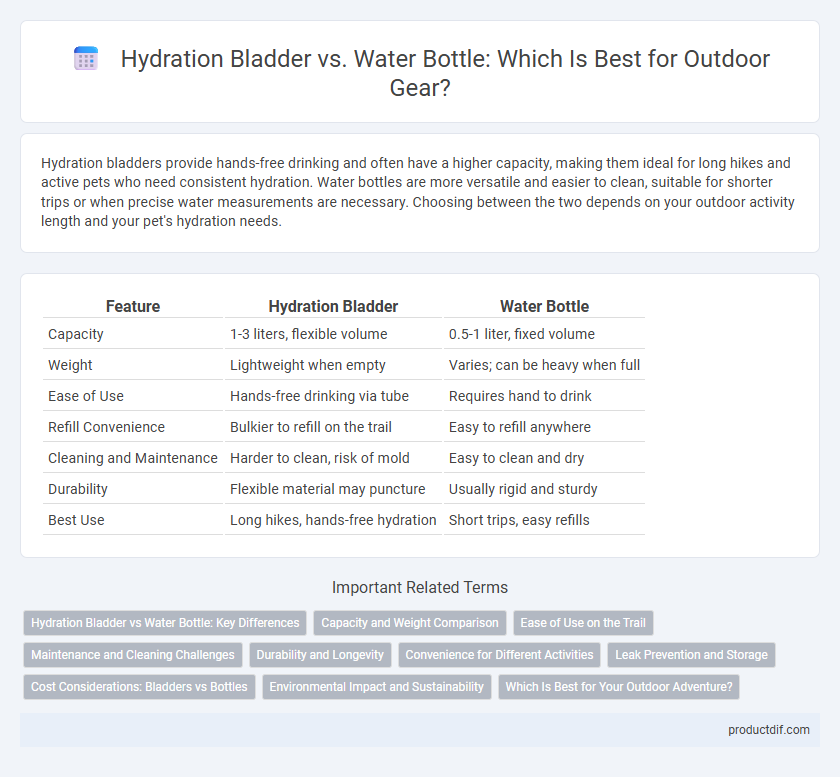Hydration bladders provide hands-free drinking and often have a higher capacity, making them ideal for long hikes and active pets who need consistent hydration. Water bottles are more versatile and easier to clean, suitable for shorter trips or when precise water measurements are necessary. Choosing between the two depends on your outdoor activity length and your pet's hydration needs.
Table of Comparison
| Feature | Hydration Bladder | Water Bottle |
|---|---|---|
| Capacity | 1-3 liters, flexible volume | 0.5-1 liter, fixed volume |
| Weight | Lightweight when empty | Varies; can be heavy when full |
| Ease of Use | Hands-free drinking via tube | Requires hand to drink |
| Refill Convenience | Bulkier to refill on the trail | Easy to refill anywhere |
| Cleaning and Maintenance | Harder to clean, risk of mold | Easy to clean and dry |
| Durability | Flexible material may puncture | Usually rigid and sturdy |
| Best Use | Long hikes, hands-free hydration | Short trips, easy refills |
Hydration Bladder vs Water Bottle: Key Differences
Hydration bladders offer hands-free drinking through a tube, ideal for continuous hydration during activities like hiking and biking, while water bottles require manual handling and frequent stops. Bladders typically hold larger capacities, often 1.5 to 3 liters, providing extended hydration without the need for refills compared to standard bottles ranging from 500 ml to 1 liter. Cleaning and maintenance vary; water bottles are easier to clean and dry, whereas hydration bladders need thorough drying to prevent mold and bacteria buildup.
Capacity and Weight Comparison
Hydration bladders typically offer larger capacities, ranging from 1.5 to 3 liters, providing continuous hydration without frequent refills, ideal for long hikes or extended outdoor activities. Water bottles generally have capacities between 500ml and 1 liter, making them lighter and more compact but requiring more frequent refills during intense physical exertion. The weight difference favors water bottles for ultralight backpacking since they lack the additional tubing and insulation found in hydration bladders, which can add extra grams to the load.
Ease of Use on the Trail
Hydration bladders offer hands-free drinking through a bite valve and hose, allowing users to stay hydrated without stopping or using their hands. Water bottles require removing the bottle from a backpack, opening the cap, and drinking, which can interrupt momentum and be less convenient on the move. The ease of sipping while walking makes hydration bladders more efficient for active trail use.
Maintenance and Cleaning Challenges
Hydration bladders require meticulous cleaning to prevent mold and bacteria growth, often needing specialized brushes and drying racks to reach inside the reservoir and tubes. Water bottles are easier to maintain due to their wide openings that allow thorough scrubbing and faster drying, reducing the risk of contamination. Regular cleaning of both is essential, but hydration bladders demand more attention and time to ensure hygiene and functional longevity.
Durability and Longevity
Hydration bladders typically feature durable, BPA-free materials like TPU or polyethylene that resist punctures and extend lifespan, making them ideal for rugged outdoor use. Water bottles made from stainless steel or high-grade plastic offer robust resistance to impact, with stainless steel models often lasting decades without degrading. Both options require proper cleaning and maintenance to maximize longevity, but bottles generally provide easier durability against drops and rough handling.
Convenience for Different Activities
Hydration bladders offer hands-free drinking and larger water capacity, making them ideal for long hikes, biking, and running where continuous access to water is essential. Water bottles provide easier refilling, cleaning, and versatility, suitable for shorter activities and situations demanding quick sips or sharing. Choosing between the two depends on the activity's duration, intensity, and the user's preference for convenience versus ease of use.
Leak Prevention and Storage
Hydration bladders offer leak-resistant designs with secure, airtight seals that minimize spillage during rigorous outdoor activities, while water bottles often risk leaks if not properly closed or damaged. Bladders typically fit snugly into backpacks with designated sleeves, optimizing storage space and weight distribution, whereas water bottles require separate compartments or external holders, potentially affecting balance. Choosing between the two depends on ease of leak prevention and efficient storage compatibility with your outdoor gear.
Cost Considerations: Bladders vs Bottles
Hydration bladders generally have a higher initial cost, ranging from $30 to $70, compared to water bottles which can be found for as low as $10 to $40. Replacement parts for bladders, such as hoses and valves, may increase long-term expenses, whereas water bottles typically require minimal maintenance. Budget-conscious outdoor enthusiasts often weigh the durability and capacity benefits of bladders against the affordability and simplicity of water bottles.
Environmental Impact and Sustainability
Hydration bladders produce less single-use plastic waste compared to disposable water bottles, making them a more sustainable choice for outdoor enthusiasts. Their durable, reusable design reduces landfill contributions and lowers the carbon footprint associated with plastic production. Water bottles, while reusable, often require frequent replacement due to wear, leading to increased environmental impact over time.
Which Is Best for Your Outdoor Adventure?
Hydration bladders offer hands-free, continuous water access ideal for high-intensity activities such as trail running or biking, while water bottles provide easier cleaning and better durability for rugged, less technical adventures. Choosing the best option depends on your activity's intensity, duration, and convenience needs, with hydration bladders excelling in quick hydration and water bottles favored for simplicity and robustness. Outdoor enthusiasts should consider factors like capacity, weight, and ease of refilling when deciding between a hydration bladder and a water bottle.
Hydration bladder vs Water bottle Infographic

 productdif.com
productdif.com